I will keep this short, the forum software requires a migration, and currently it’s not secure. To avoid any security issues going forward, I have made the decision to make it offline. It’s not being used anyway and Reddit /r/Totse works anyway.
Most of the info is on wayback machine anyway. I am honestly focused on other stuff IRL and I don’t have the team to keep things rolling on a project that has run it’s course. I loved every bit of but I want to focus on other stuff and not worry about getting hacked.
Thanks for the memories. Totse is still around just in other branches. Time to move on.
Category: The Stash
Covers everything from Tech to Sex.
-
Going Offline!
-
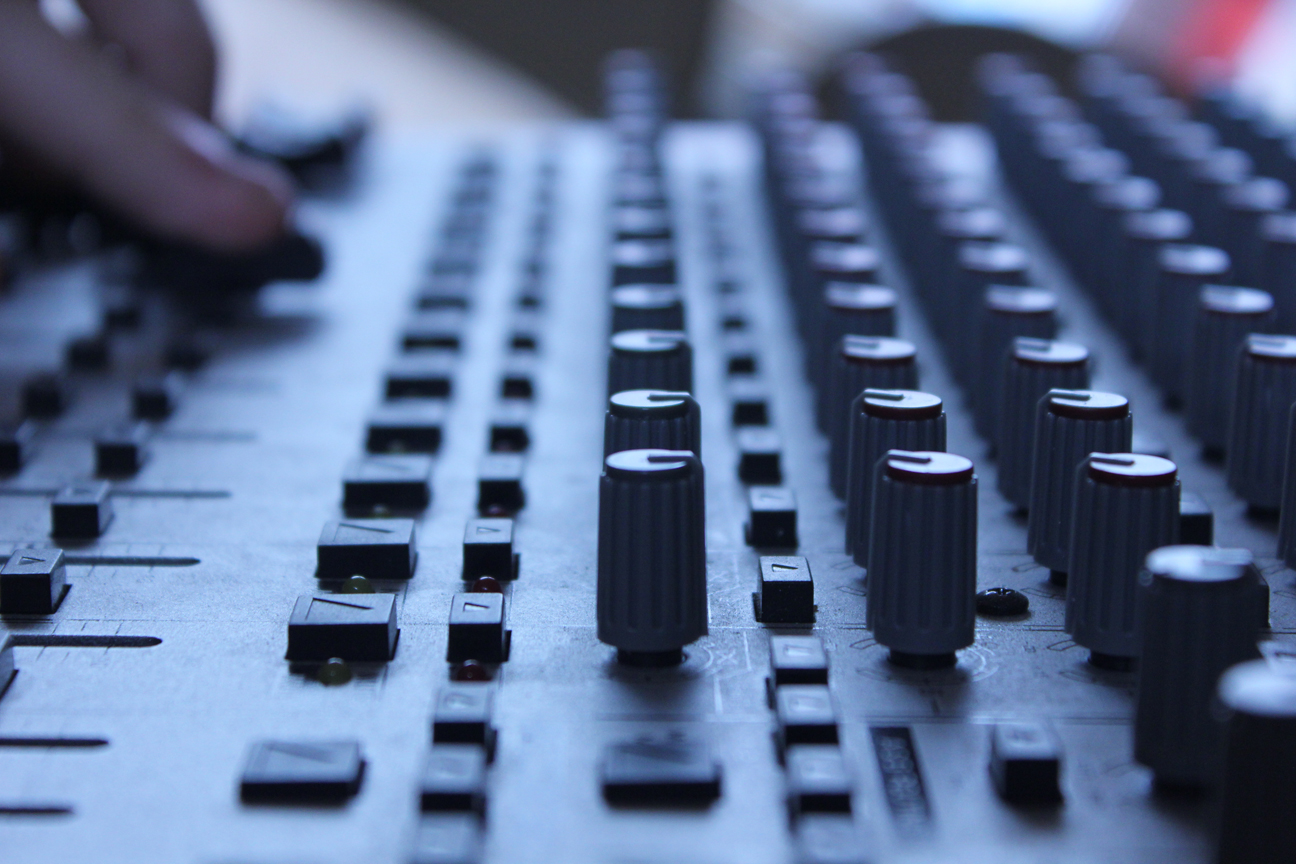
The Historical Background of Music Technology
The Historical Background of Music Technology
By Nahum Bolt
Throughout the history of music, its only limiting factor has been the technology that was available at that time. Rock was changed irreversibly by the solid body electric guitar, Classical music was changed by the addition of instruments such as the modern piano and clarinet, dance music by synthesizers etc. The role of music technology that I will be looking at is the way that recording studio software has developed, and how it has impacted on everyday music consumers. The development of recording software also ties in with the rise of do-it-yourself recording and the impact on live music. Home recording has been instrumental in allowing anybody to make a professional recording in the comfort of their own home, and gives the musician or band complete freedom to do what they like and create the music how they want it. For example, Rebecca Black released a track called Friday on YouTube, and at once people made many parodies of that song. That could not happen back then, as they would have needed a professional recording studio and that would have been too expensive. At the end of the day, music software was created because people were tired of writing music out by hand. As the software evolved, musicians and Studio engineers realized that you could do so much more with it like using it to mix and master tracks, and as a new way to edit the music without re-recording it. The midi interface made this all possible, as it allowed any instrument to interface with the sequencing or notation software so that musicians could directly play into the program without needing a mixing desk. Midi allowed the recording software to be used to its full extent, especially for home users who can go from midi to usb into their computer and record a music track, and then upload it the next day to a video sharing website where it will be viewed.
The history of recording software runs parallel with the development of the personal computer, and eventually branched out to either software on the Microsoft Windows operating system or on the Macintosh operating system. When they were created, they were quite limited at that time mostly due to the limitations of the computer it was running on, however now that is changed and the only limitation is what hardware that you use. The 1980’s is a period of time where music production and recording was very important, and the first of these software applications were written for various popular micro-computers of the time like the Commodore C64, Sinclair ZX Spectrum and Apple II. Apple increased in in popularity because of its graphical user interface (windows with icons and mouse pointer), so the first sequencer for Mac was developed by Mark of the Unicorn and it was called performer. The Atari ST was also very popular as because it was a gaming computer it implemented the Midi interface, and at the same time it was cheaper than the Mac. Steinberg Cubase and Emagic Notator (now known as Logic) were developed for the Atari ST. Now unlike the Mac, the first Microsoft Windows were not that stable at that time but nonetheless Cakewalk MIDI sequencer and the SCORE music notation package were the first music software to be made for the Windows platform. At then end of the 1980’s, another key software program called Finale was created for the Mac (very very popular until Sibelius overtook it in recent years). In 1989 Digidesign introduced sound tools, a two-track recorder which provided mono or stereo recording/editing/playback as well as DSP effects like EQ, Gain Change, and noise reduction. In 1990 the first MIDI and audio sequencer was produced using Studio Vision and used Digidesign’s sound tools for the audio. Pro Tools was released in 1992. Later on in the 90s, Cubase and Steinberg both added score writing features after the program Sibelius was created for the not very popular microcomputer Acorn Archimedes. An entire new market was created when Steinberg created the VST plugin, and other companies quickly followed. Around 2002, Pro Tools became the standard software used in Studios. Apple took over Logic so now it is only available for the Apple platform.
Impact on technology on music consumers
Recording software has bridged the gap between the music maker and the music consumer. With a bit of knowledge anyone can re-mix any audio track to their liking, for an example many people create dance tracks out of popular music.
Recording software has a massive impact on live music. No longer does a musician have to be inhibited by only a select range of sounds that he/she can use, but the VST plugins are endless and therefore the different sounds one can achieve are endless. Thus, there is a lot more variation with how tracks can be performed live because you can use a program like Ableton Live or any other sequencer to play any sound that you wish while you are performing. For an example, if you wanted a bass drop as some are fond of doing, then you can just hook it up to the computer.
In Popular music, what the music consumer hears is such a radical difference to what they would actually hear if the technological advances in sequencing programs had not been made. Audio engineers are able to manipulate the audio in whatever way they wish, so they can make it absolutely perfect. If that means replacing the drum track then that is what they do, substituting a VST drum track that sounds perfect in its place and if a good master has been done then the audio engineer has made up for what is lacking in the environment and the instrument. Thus when the music consumer buys any cd of the shelf, the only complaint he/she makes is about the artist and not about the quality of the recording.
Because of the popularity of home studios, they allow musicians to record professional tracks at home rather than go to an expensive studio instead. This means that far more music is being made and listened to because of the convenience the artist has and the relative inexpensiveness. Also, when a music consumer listens to the track that has been made, they are listening to the track that has been recorded by them, mixed by them, mastered by them and played by them. Therefore, you are listening to something that is entirely who the band wants it to sound like and not the influence of a producer or engineer.
In conclusion, I think that music software is one of the most important developments in recording, and I do believe that it has opened up the world of music to a whole new level. In this world where you may get famous from your music on the internet, recording at home plays an ever greater part in today’s society.http://www.hypnotic-audio-secrets.com/blog/466/recording-studio-software-history/
-
Using an Oscilloscope
An Oscilloscope is a very useful piece of test equipment to have if you are working on electronic circuits or equipment. It can be used to find problems or check that everything is working correctly. For example, making sure the filtering in a DC power supply is filtering the output correctly or checking the output of a logic controller among other things.
So lets take a look at an oscilloscope. You will find the controls are generally the same on all “scopes” but they may differ if they are a single or dual channel scope. The one below is a single channel scope which means you can only measure one point of a circuit at any one time. They come in either CRT or LCD display models, CRT based scopes are generally cheaper although the newer digital LCD based scopes allow you to record and save info displayed on screen.
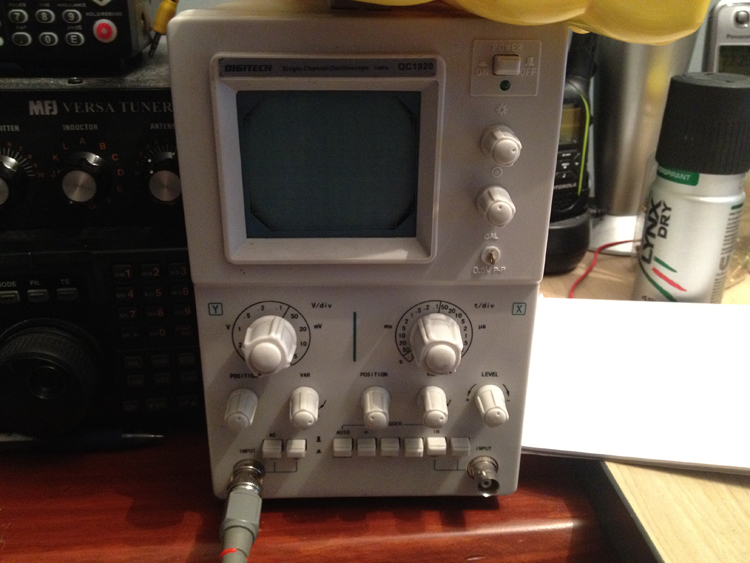
You have two main controls, these are the volts per division and time per division. Time on the X axis of the screen and voltage on the Y axis. On the screen there is a grid pattern, each square is one division. Generally most scopes are adjustable between 5 volts/div down to a few mV/div. Range of time/div is dependant on the frequency range of the scope, most cheap scopes only going up to 10-20 MHz max although more expensive ones will measure up to a few GHz or more.
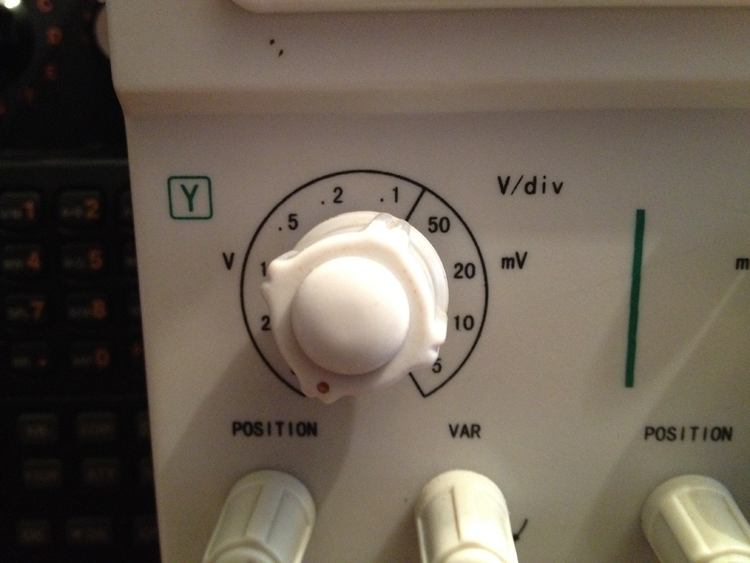
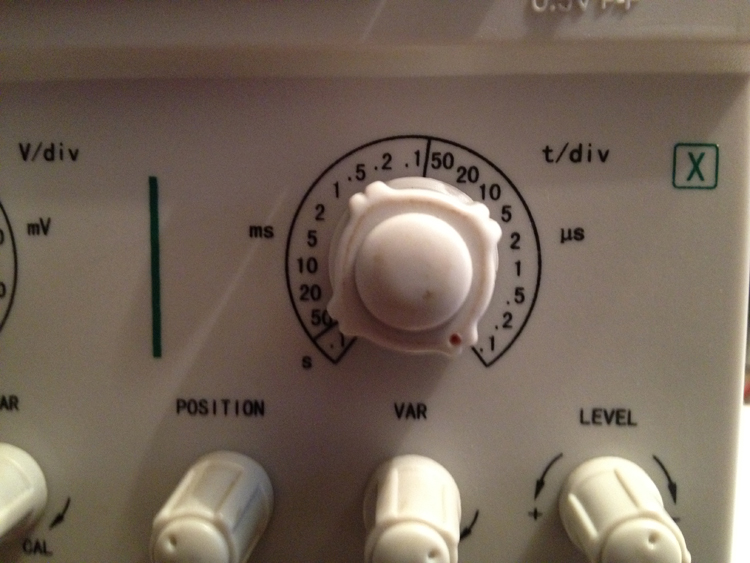
Below the time and voltage controls are the trace position controls. The trace is the line going across the screen and can be moved up and down, left and right. Also there are the calibration controls (var) and the level control.
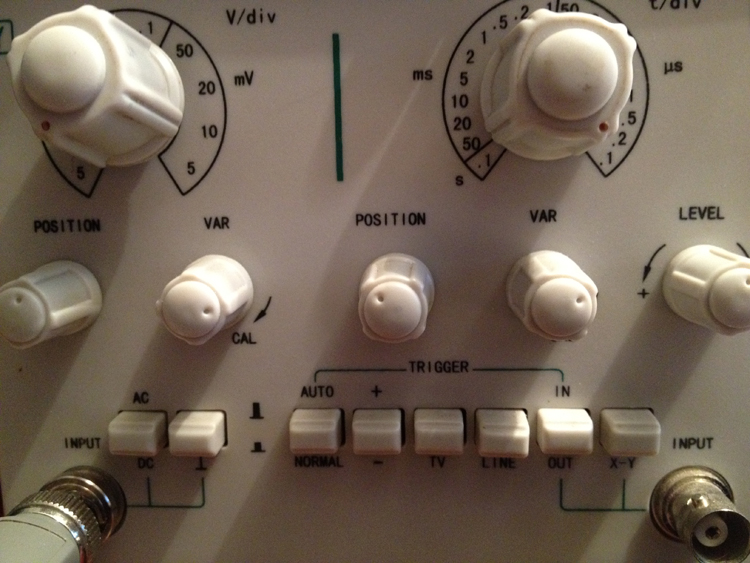
Below this is the AC/DC select button and Ground button (the inverted T)along with the Trigger controls and X/Y select button. The trigger can be left on auto as you won’t usually use it unless there is a need for it dependant on the circuit under test. The X/Y control allows you to connect a signal to the X/Y plates in the tube for instance by feeding two sine waves 180 degrees out of phase onto the X and Y inputs you will see a perfect circle appear on screen. Be very aware that you don’t leave the scope set to X/Y with no input as the resulting dot you will see on screen will permanently damage the phosphor on the CRT screen if left for length of time. LCD models obviously won’t have this issue. You can use this setting to centre the trace on the X axis but only do it with the brightness set low enough that you can just see the dot so the phosphor isn’t damaged while you make the adjustment. Just don’t leave the dot on one point of the screen for a long period of time.
This will damage the phosphor very quickly.
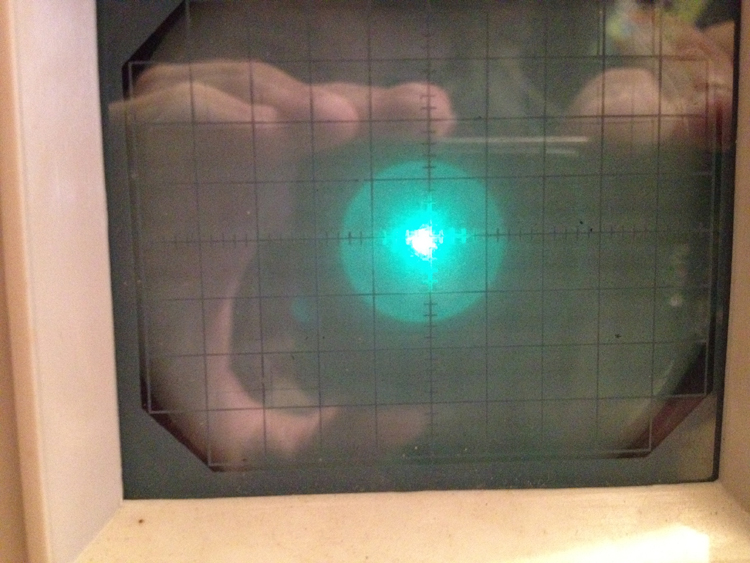
If you use the X/Y setting to centre the traces, set the brightness low like this.
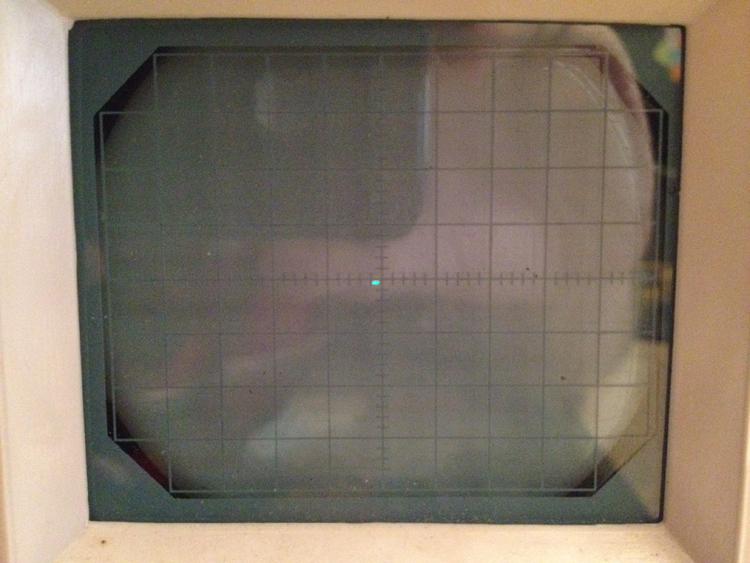
To the left of the display are the brightness and focus controls. The calibration output is a brass tab below these controls providing a 1 KHz square wave at 0.5 volts peak to peak. This is standard on all oscilloscopes. To calibrate the scope, take your probe and clip it to this tab leaving the ground lead disconnected. Set the volts/div to .5v/div and time/div to 1ms/div, adjust level control until you see a square wave on screen. Hit the ground button which is labelled “ground” or has a ground symbol on it, the square wave should disappear. Centre the trace on the centre line of the screen using the position controls and then hit the ground button again, the wave should reappear on screen. Adjust the Y axis so the top and bottom of the wave are half a division from the centre line. Adjust the X axis so the top right of the first peak and the second peak are one division apart. Disconnect the probe and you are done, your scope is now calibrated. I would suggest checking the calibration each time you use the scope just in case it has changed slightly.
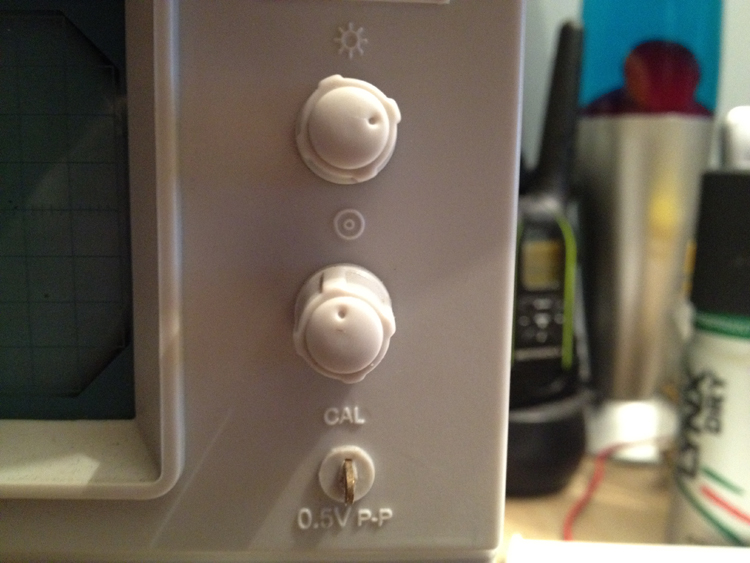
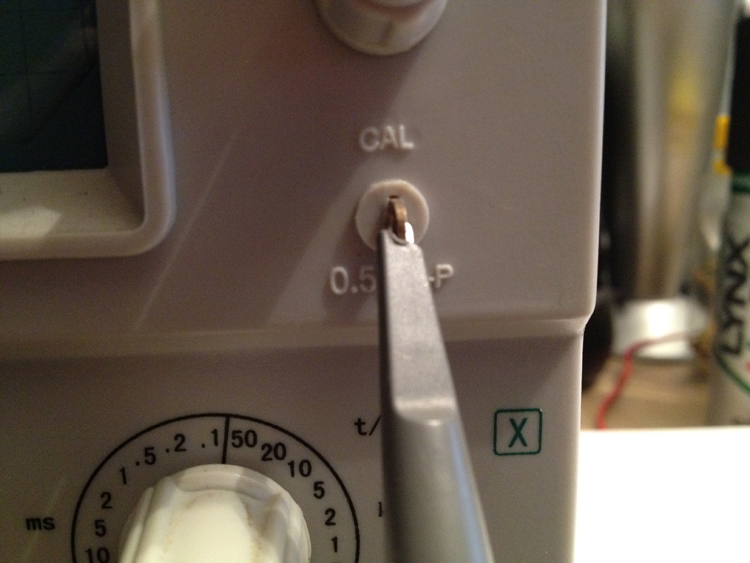
You should see something like this when calibrating the scope
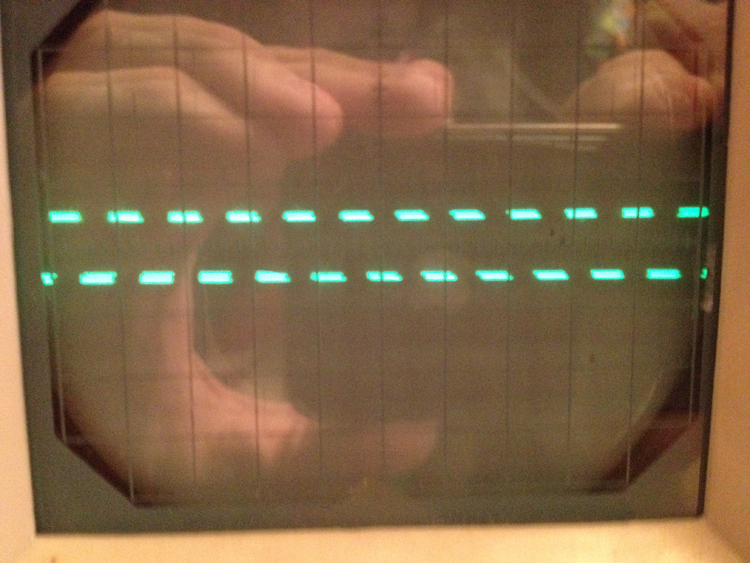
The Probe
As you can see below we have a typical oscilloscope probe.
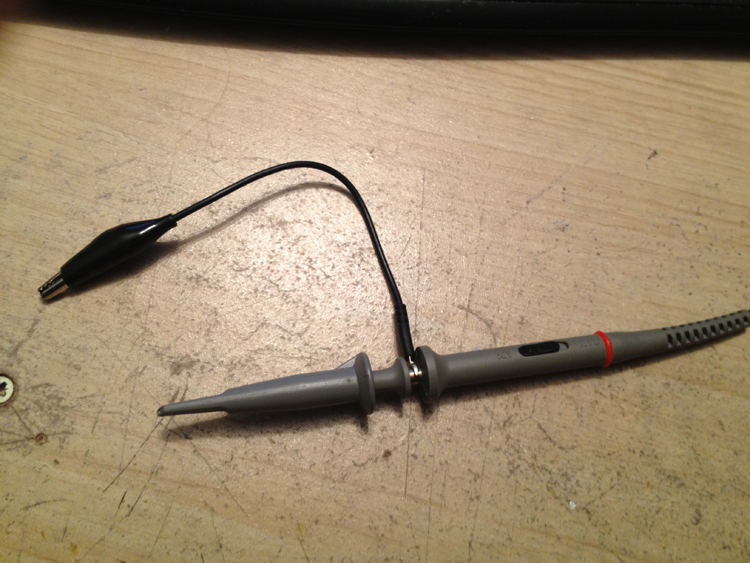
On the end is a hook which if you pull the plastic end back, exposes it. This plastic hook end is generally detachable by simply sliding it off the end of the probe. The black lead is the ground clip which you connect generally to the ground point of the circuit. It is bonded to the scope ground and the grounding pin of the mains power cord. Be aware that if the circuit under test is mains powered or even connected by USB to a PC like an Arduino for instance, connecting the ground lead across the wrong point could create a short circuit damaging the circuit under test, the scope or your self. With a dual channel scope, connect the ground leads of the two probes to the same point in the circuit for the same reason. You can connect them to different points if you use a differential amplifier with the scope which is designed with this in mind. Never remove the ground pin from the mains lead as the scope needs this connection to operate correctly.
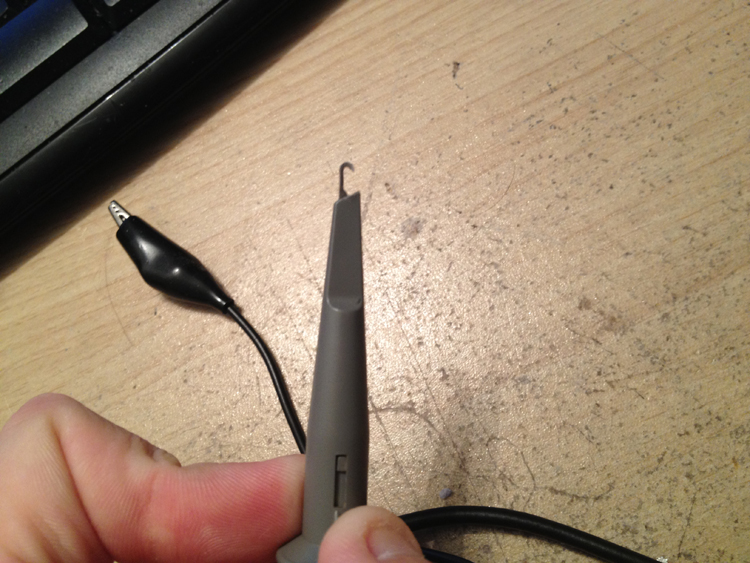
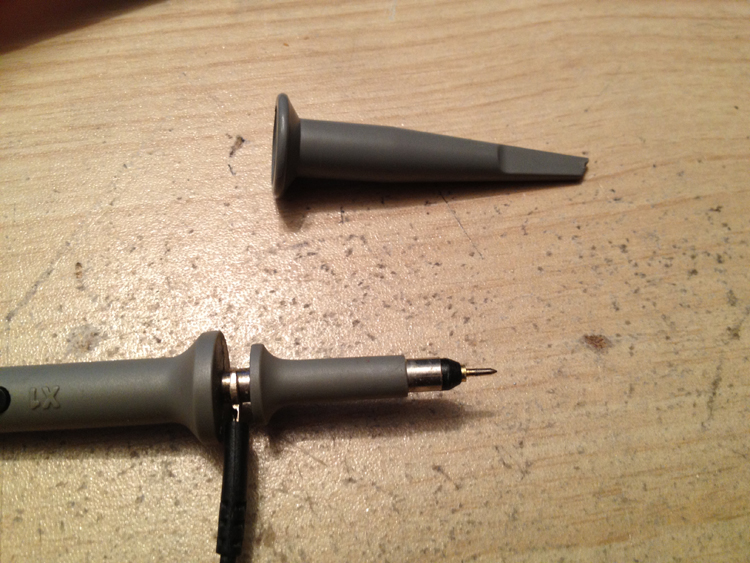
On the probe is generally a switch which in this case is marked X1-X10. This is an attenuator probe, what this means is that say for instance you want to measure a 50 volt AC supply. The scope only goes up to 5v/div so 20 volts max. What you do is flick that switch from X1 to X10, now each 5 volt division is 50 volts. It lowers the volts/div by a factor of 10 allowing the measurement of high voltages using the scope. You can get different probes with differing attenuating values.
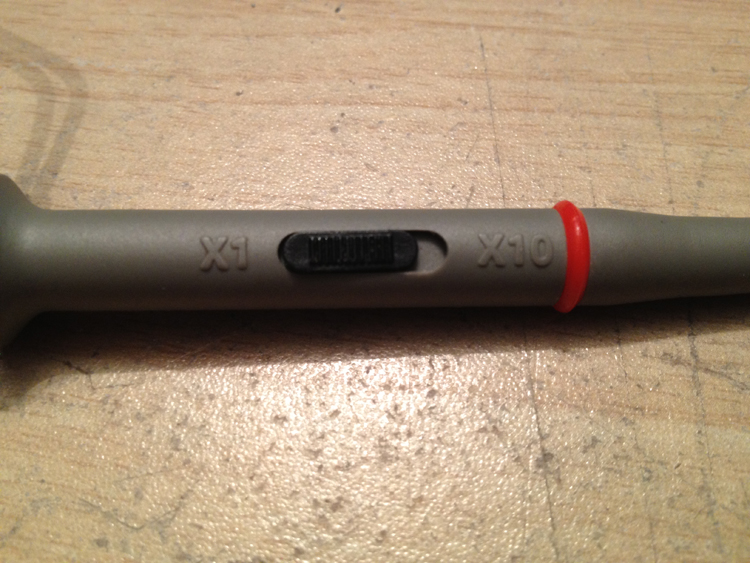 http://totseans.com/wp-content/uploads/2012/08/IMG_0648.jpg
http://totseans.com/wp-content/uploads/2012/08/IMG_0648.jpgThe oscilloscope is a pretty handy piece of equipment and once you learn the basics, very easy to use particularly the CRT models at the expense of some modes and the ability to pause and analyse events. A single channel, 10 MHz CRT scope will set you back around $150 – 200 at the most and will be more than enough to do basic testing.
Written by Dakologist
-
The most crazy 24 hours of my life
This event was not documented in any way. The entire thing was absent of me having my mobile phone and a way of documenting what happened on me. You’ll see why.
My Father has a friend from Holland who deals in contraband. It’s a hard business, but I was told of this weekend a few days before. Literally a phonecall from an unknown number
“Hey [RemadE], fancy making some money this weekend?” and I instantly knew the voice.
“Of course”
“Good. Be at mine for 4pm, bring overnight stuff”And that was it. I got the bus back and headed straight to my mates house. I had packed my meds, a change of clothes, a coat, pillow and some reading material. Just in case I had a spare few minutes.
We set off at 4:30 to Gatwick and got on a plane to Amsterdam. In short he only needed me to help him bring back some contraband as there were 2 of us, so that’s twice as much. Simple enough – but the journey was the hilight.
After reading and getting off the plane we were greeted by some friends in suits. I never got their names. Most of the people I still don’t recall their names, but that’s the beauty of it all.
Throwing my bag carefully into the boot of the Mercedes CL500 we got heading to a house where the goods were kept. It was still daylight and I was still pretty whacked out from flying, then just being whisked off my feet.4 of us in this car, we eventually got to this small house outside Amsterdam.
“I’m not allowed back in the City, you see” he told me.
“I remember you saying why” I replied. This guy was not to be fucked with. Amsterdam is a hotbed of mafia-style groups and his tattoos showed his dues.The car pulled up on the drive and we went in. All we came here was to pick up some gear and go back. But that wasn’t happening anytime soon.
“I’m a regular customer of the travel companies. They don’t care if I miss a boat or plane. I just pay them an extra €10 and I’m on the next day. Relax.”I put my bag down and the room was a traditional, mahogany coloured place. Being in Holland there were drugs around and businessmen all reclined around tables. I didn’t know if this was for leisure or business. But fuck it, I followed my mates lead and had some attention from some females. Outside was a hot tub and a few girls hitting a bong. If anything I felt like Robert Deniro in “Jackie Brown”. These guys were loaded, dangerous and there I was, just a +1 and about to get into the swing of things.
I was told we are leaving at 4am to get the ferry back
“Customs aren’t as half as bad there”I now had 5 hours to enjoy myself. It was a haze of chatting shit, watching cocaine get snorted off glass tables, boobs, veuve cliquot and money being counted. The whole thing could have been pulled straight from a fucking movie. Needless to say I dabbled, but had to keep straight for our journey back.
As 4am inched nearer I eyed my mate up who was catching up with some friends. I said goodbye to the girls and shook the hands of the men I met and we left the house to return to another car. Not quite a Mercedes, as it was a Citroen, loading it up with the contraband we were bringing back.
As I was getting into the car“Stop”
“What’s wrong?”
“Come here” my friend commanded.
“O-k”He patted down my pockets and looked at my nose. Checking me over for drugs seemed pretty sensible. Completely pissed through my mind, so glad to see he was still on the ball.
“Being caught with this stuff is bad enough, but being caught with what they had in there is even worse. You Brits are too serious about life”“Ok let’s go”
That night saw us drive through Belgium and into Northern France, passing his house where I stayed a few years before, and pulling into the Nord Pas De Calais Ferry Port. Patiently waiting.
Waiting.
And driving back onto the boat.It wasn’t even the rush of customs that got me about this story. it was the crazy European experience I had over the course of 24 hours, and I am now back in my University room wondering what the hell just happened.
A weekend I will never forget.
-
That’s life!
I just got in from the cold. My body clock is whacked out and so I sleep for most of the day, get work done at night. However the silence gets to me.
Texting old &ToTSE members, I went outside for a smoke and listened to “That’s Life” by Frank Sinatra, realising the people that have gone from my life, through their own choice or mine.Anyway, coming back in I saw that the new episode of the Walking Dead was almost downloaded (S02E07) and so I thought I’d get some work done while the last 5% downloads. This University stuff is never-ending.
I apologise for my lack of activity on &T, as I have been preoccupied and ill as hell. Going to the loo 5ft from my bed) is enough challenge as getting out of bed is agony, so getting to my laptop is another challenge. Shit ain’t cool.
Also this past week I’ve found that selling pharmaceutical drugs can be very profitable. Meeting people at lectures when I have the energy to go. More spending money for my Holiday in December with an old &T member. I’ll work hard on getting better and will have to show you the photos. Aww yeah.
In other news, I’ve found out I’m vaguely related to the Actress Lauren Cohan than I realised.
Life is mad at the moment, but don’t worry – I still watch over my beloved Community. Just taking things easy at the moment